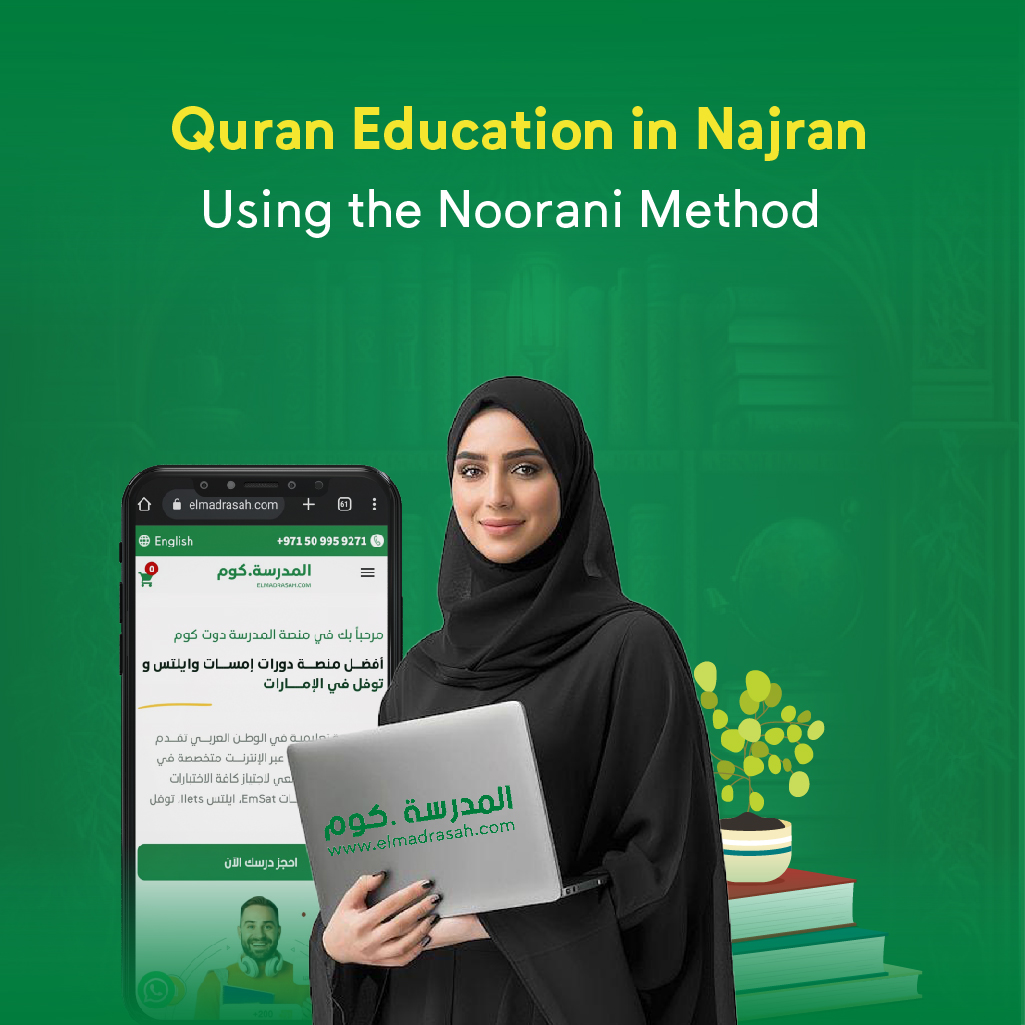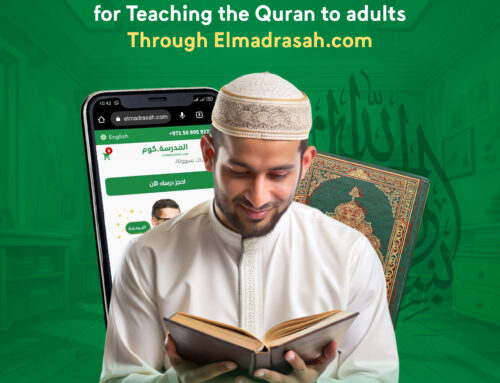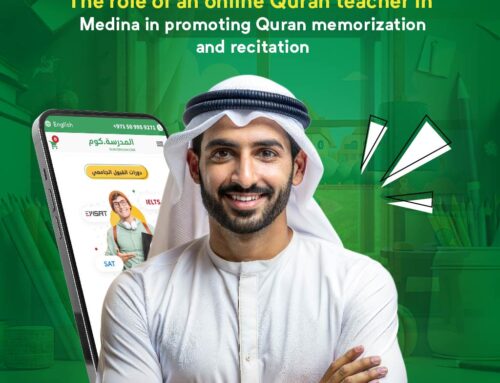
Quran Education in Najran using the Noorani method is one of the prominent modern approaches that contribute to enhancing reading and recitation skills among students. This method relies on a comprehensive curriculum that combines deep understanding and correct pronunciation, enabling learners to effectively grasp the texts of the Holy Quran, In this article, we will explore how the Noorani method serves as a fundamental pillar in the educational process and how it contributes to bringing about a positive change in the skills of students in Najran.
What is the Noorani Method and Its Importance in Quran Education in Najran?
The following points illustrate what the Noorani method is and its significance in Quran Education in Najran:
- Definition of the Noorani Method: The Noorani method is an educational approach that focuses on gradually learning the Arabic alphabet, aiming to master correct reading skills and understand the rules of Tajweed. It is considered an effective method in Quran Education in Najran.
- Beginning of the Noorani Method: The Noorani method originated in India in the 19th century and later spread to many countries, including the Kingdom of Saudi Arabia, where it has become a popular method in Quran Education in Najran.
- Improving Pronunciation and Tajweed: Through the Noorani method, students learn the correct pronunciation of Quranic letters, which enhances their recitation and mastery of Tajweed. This makes Quran Education in Najran using this method more effective.
- Enhancing Quranic Understanding: The Noorani method relies on understanding the rules of reading and Tajweed, helping students to grasp the meanings of the Quran more deeply during their learning in Najran.
- Ease of Learning for All Ages: The Noorani method is suitable for all age groups, from children to adults, which enhances its prevalence in Quran learning centers in Najran.
- Tangible and Rapid Results: Due to its ease of application, noticeable and rapid results appear in improving reading and Tajweed levels, making Quran Education in Najran more effective with this method.
Benefits of Applying the Noorani Method in Teaching Tajweed in Najran
Here are the benefits of applying the Noorani method in teaching Tajweed in Najran:
- Improving Correct Pronunciation of Letters: The application of the Noorani method helps learners in Najran master the correct pronunciation of Quranic letters, enhancing their Tajweed skills.
- Facilitating Learning Tajweed Rules: The Noorani method adopts a gradual approach that simplifies the understanding of Tajweed rules, making Quran Education in Najran easier and more comprehensible for all ages.
- Increasing Focus in Reading: Through intensive training on letters and syllables, learners learn to focus on the precise details of recitation, enhancing the quality of Tajweed Education in Najran.
- Improving Memorization and Recitation Levels: The application of the Noorani method contributes to improving memorization levels by enhancing the ability to read correctly, which raises the standard of Quran Education in Najran.
- Suitability for All Age Groups: The Noorani method is appropriate for both children and adults, broadening the scope of Tajweed Education in Najran to include diverse segments of the community.
- Rapid and Effective Results: Due to its easy application and gradual nature, the Noorani method shows quick results in improving recitation and Tajweed, thereby enhancing the effectiveness of Quran Education in Najran.
In summary, the Noorani method is a transformative approach that plays a significant role in Quran Education in Najran, making the learning experience richer and more effective for students across various age groups.
Innovative Educational Strategies to Support Tajweed Learning Using the Noorani Method
Here are some innovative educational strategies to enhance Quran education in Najran and support Tajweed learning through the Noorani method:
- Play-Based Learning: Integrate educational games focused on Quranic Tajweed, such as reading competitions or interactive apps that allow students to practice Tajweed in a fun way.
- Project-Based Learning: Encourage students to work in groups to create projects related to Tajweed, such as producing educational videos that demonstrate how to apply Tajweed rules.
- Utilizing Technology: Provide educational apps and programs that assist students in practicing Tajweed, such as those featuring Quranic recitations by professional teachers, allowing them to listen and mimic.
- Learning Through Narration: Utilize Quranic stories to teach Tajweed, employing specific texts to illustrate how to apply Tajweed rules, making the learning process more engaging.
- Interaction and Participation: Encourage group discussions about students’ experiences with Quran reading, where they can share opinions and tips on applying Tajweed rules.
How the Noorani Method Helps Improve Reading Skills for Learners
Quran Education in Najran through the Noorani method enhances learners’ reading skills by:
- Teaching Letters and Phonetic Syllables: The Noorani method begins with detailed instruction on letters, enabling students to understand the fundamentals of reading and build correct pronunciation skills.
- Gradual Increase in Difficulty: The Noorani method relies on a gradual teaching approach, allowing learners to transition from simple letters to syllables and sentences over time, thereby developing reading skills progressively.
- Enhancing Phonemic Awareness: Through practice on diacritics and elongations, the Noorani method helps learners distinguish between different sounds in the Arabic language, which is essential for improving reading skills.
- Repetition of Recitation: The Noorani method emphasizes repetition and intensive practice, helping learners improve their reading fluency and avoid mistakes.
- Reinforcing Tajweed Rules: The Noorani method simplifies the teaching of Tajweed rules, positively impacting the quality of recitation and enhancing their ability to read the Quran correctly.
Scientific Foundations of the Noorani Method in Teaching Reading and Tajweed
The scientific foundations of the Noorani method for memorizing the Quran and Tajweed are based on several strong principles, including:
- Gradual Learning: The Noorani method emphasizes teaching the Arabic alphabet gradually, helping learners build their skills systematically, from individual letters to words and sentences.
- Focus on Repetition: A key scientific principle of the Noorani method is the repetition of letters and phonetic syllables in a manner that aids learners in retaining information in their memory. Research confirms that repetition enhances learning.
- Activating Phonemic Awareness: The Noorani method focuses on teaching the Quran in Najran to learners using the correct sounds of letters and diacritics, contributing to the development of their phonemic awareness, which is crucial for improving reading and Tajweed skills.
- Linking Visual and Auditory Learning: By combining visual reading with listening to correct recitation, learners learn to connect what they see with what they hear, enhancing their ability to read correctly and apply Tajweed.
- Gradual Application of Tajweed Rules: The Noorani method simplifies Tajweed rules and presents them progressively, aiding learners in fully understanding them without feeling overwhelmed or pressured.
By incorporating these strategies and scientific foundations, the Noorani method effectively supports Quran Education in Najran, learning of Tajweed, and improving reading skills among students in Najran.
How to Motivate Students to Quran Education in Najran Using the Noorani Method?
To motivate Quran Education in Najran using the Noorani method for memorization, several effective strategies can be adopted:
- Encouragement with Rewards: Offer simple and immediate rewards when students master reading skills or memorize parts of the Quran using the Noorani method, such as certificates of appreciation and symbolic gifts.
- Providing an Enjoyable Learning Environment: Make Quran education sessions using the Noorani method more interactive and enjoyable by utilizing educational games or technological tools that encourage students to engage and participate.
- Enhancing Self-Confidence: Continuously provide positive feedback to students when they show improvement in reading and recitation, increasing their confidence in their abilities and encouraging them to continue using the Noorani method.
- Presenting Successful Role Models: Share stories or examples of other students who have successfully memorized the Quran using the Noorani method, inspiring students and making them feel they can achieve similar results.
- Diversity in Teaching Methods: Apply the Noorani method interactively by using sounds, images, and videos, making learning more appealing and motivating students to commit to it.
The Noorani Method’s Role in Enhancing Comprehension of Quranic Texts
The Noorani method plays a significant role in enhancing the comprehension of Quranic texts through the following points:
- Presenting Meanings Simply: The Noorani method relies on explaining letters and words in a simplified manner, making it easier for students to understand the fundamental meanings of Quranic texts during Quran education in Najran.
- Gradual Learning: By gradually presenting content, the Noorani method helps students build a solid understanding of texts, focusing first on letters and then on syllables, thereby improving their comprehension of Quranic texts.
- Linking Reading and Understanding: The Noorani method focuses on connecting correct reading with understanding meanings, teaching students how movements and recitation affect meaning, thereby enhancing their ability to comprehend Quranic texts.
- Applying Rules to Texts: The Noorani method trains students to apply recitation rules while reading, helping them understand how correct pronunciation affects the meanings of words in the Quran.
- Enhancing Spiritual Connection: By focusing on understanding texts and their meanings, the Noorani method enhances students’ spiritual connection to the Quran, making them more interested in memorizing and comprehending it, ultimately improving their understanding during Quran education in Najran.
The Psychological Impact of the Noorani Method on Motivating Learners in Najran
Quran Education in Najran using the Noorani method positively affects the psychological motivation of learners through several aspects, including:
- Increased Self-Confidence: Achieving noticeable progress in reading and recitation skills makes learners feel confident in their abilities, motivating them to continue learning and committing to memorizing the Quran using the Noorani method.
- Motivation for Success and Excellence: The Noorani method promotes the concept of success by quickly yielding tangible results, boosting learners’ enthusiasm, and elevating their spirit of positive competition.
- Reducing Stress and Anxiety: The method relies on gradual learning and repetition, helping reduce anxiety levels among learners, as they feel they are learning in an organized and clear manner, which facilitates their comprehension of the material.
- Enhancing Community Belonging: Through group learning, learners feel they are part of a collective effort to achieve a common goal, strengthening their sense of belonging and contributing to their motivation to commit to memorizing the Quran.
- Fostering Enthusiasm for Learning: The interactive approach of the Noorani method makes learning more enjoyable and exciting, enhancing learners’ enthusiasm for attending classes and continuing their education.
Cultural and Social Challenges in Implementing the Nourania Method in Najran
Quran Education in Najran through the Nourania method faces several cultural and social challenges, including:
- Differences in Educational Understanding: Teachers and students may encounter differing understandings regarding how to apply the Nourania method, which can lead to resistance or difficulties in effectively adopting it.
- Educational Traditions: Some families and communities in Najran may be attached to traditional teaching methods, hindering the adoption of the Nourania approach as a new way to enhance Quran learning.
- Lack of Awareness of the Method’s Importance: Some individuals suffer from a lack of awareness about the benefits of the Nourania method, resulting in disinterest in its application within educational institutions.
- Economic Challenges: The implementation of the Nourania method may require financial resources to support training and development, and economic conditions can pose challenges in providing these resources.
- Qualifications Gap: Some teachers may face challenges in obtaining sufficient training to effectively implement the Nourania method, which impacts the quality of education.
How to Overcome These Challenges?
To overcome the cultural and social challenges in implementing Quran Education in Najran, the following strategies can be adopted:
- Raising Awareness and Education: Organize workshops and awareness seminars to inform the community about the benefits of the Nourania method and its positive impact on improving Quran education, thereby enhancing its acceptance.
- Teacher Training: Provide comprehensive training programs for teachers on how to effectively apply the Nourania method, helping them to address educational challenges in a thoughtful manner.
- Community Engagement: Invite parents and the community to participate in educational activities, enhancing their understanding of the importance of the Nourania method and encouraging their support.
- Curriculum Adaptation: Work on adapting educational curricula to suit local culture and meet student needs, making it easier for learners to adjust to the Nourania method.
- Strengthening Collaboration with Institutions: Collaborate with educational and religious institutions to promote the use of the Nourania method in schools and mosques, contributing to a supportive educational environment.
By implementing these strategies, it is possible to overcome challenges and enhance the effectiveness of the Nourania method in Quran Education in Najran.
The Role of Elmadrasah.com in Providing a Comprehensive Curriculum for Quran Education in Najran
Elmadrasah.com is an online educational platform in the UAE that offers a comprehensive Quran Education in Najran through specialized teachers, modern technologies, and dedicated courses for teaching the Quran to children, through several aspects including:
- Flexible Educational Platform: Elmadrasah.com provides a flexible electronic educational platform that allows students to access comprehensive educational content anytime and anywhere, facilitating the process of learning the Quran and Tajweed.
- Diversity of Educational Materials: The platform offers a variety of educational materials, including educational videos, interactive lessons, and audio files, enhancing students’ understanding of reading and Tajweed skills.
- Qualified Teachers: Elmadrasah.com includes a group of qualified teachers specialized in Quran and Tajweed education, ensuring the provision of high-quality education aligned with modern methods.
- Continuous Assessment: The platform allows for periodic assessments of students, helping to track their progress and identify areas needing improvement, thus contributing to enhancing their Tajweed and reading skills.
- Providing an Interactive Environment: Elmadrasah.com includes interactive features such as discussion forums and live sessions, allowing students to communicate with teachers and peers, and encouraging the exchange of knowledge and experiences.
In conclusion, Quran Education in Najran using the Nourania method remains an effective tool for enhancing reading and Tajweed skills, contributing to the development of a knowledgeable generation capable of understanding the texts of the Holy Quran. Adopting this comprehensive approach enhances a deep understanding of the Quran and reflects the values of modern education in the community.















